The strongest brands are the ones that build connections. They’re familiar, easy to relate to, and consistent throughout all their channels, both digital and offline. And sure, they use the same branded images, logos, and colors to create an easily recognizable identity.
But they don’t stop there.
Strong branding doesn’t just come from the way your brand looks online. It also comes from how you sound––aka your brand voice.
Now, some people might think it sounds a bit silly. How can a brand have a voice? But we’re not talking about things you might associate with the voice of your favorite singer, like pitch or range.
What we’re talking about is the distinct language, messaging, or tone your brand uses when talking to customers and prospects, both in person and online.
Having a unique brand voice can help you attract the right audience, form deeper connections with your prospects, and make customers more loyal to your brand––but only if you create and use your brand voice the right way.
In this post, we’ll talk about:
- What exactly is brand voice
- Why is brand voice important?
- How to create brand voice guidelines
- Examples of brand voices
- How to use your brand voice in customer and prospect communications
So, what exactly is “brand voice?”
Brand voice refers to the personality, emotions, and language your company uses throughout all external (and sometimes internal) communications. It supports your visual branding elements to help create your brand’s story.
Your brand voice––just like your company colors or logo––should tell a story about who your company is and what you do. It should connect with the audience you’re trying to attract and round out the experience you’re delivering to your customers.
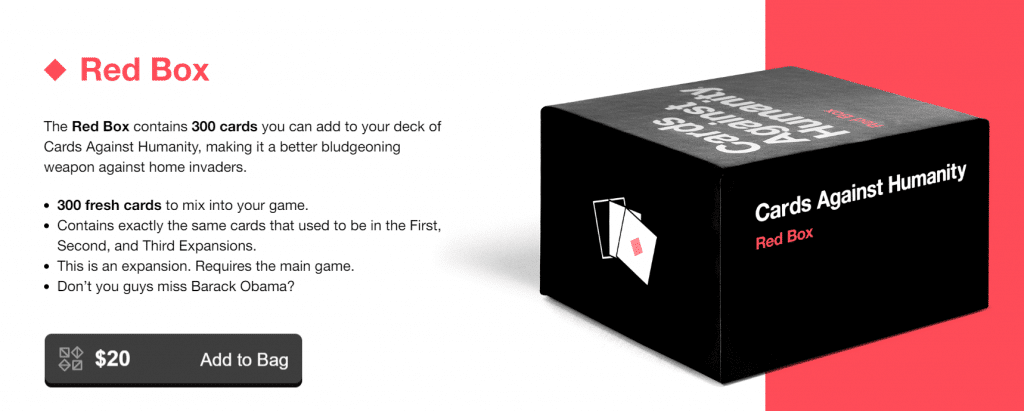
Cards Against Humanity uses their sometimes-inappropriate-but-always-hilarious voice in everything they do––from email campaigns to product descriptions.
Why is brand voice important?
Visual branding elements can only do so much. While your logo might attract attention or your colors might evoke certain emotions, your brand voice is really what creates relatable, engaging experiences for your customers.
Your brand voice is the key to connecting with your target audience. It adds a humanizing element to your company that gives them something to identify with. Establishing a brand voice also creates consistency. It makes your brand easily recognizable and lets your audience know exactly what you’re all about.
In other words, your brand voice brings your company’s personality to life.
How to create your brand voice guidelines using a template in 4 steps
Before we get into how to do it, let’s understand why we need brand voice guidelines.
One incredibly important part of a strong brand voice is consistency. If the language and messaging on your social media pages don’t match what’s on your website, it can throw off your target audience––potentially pushing them away from your brand. How?
Think about it this way. Imagine someone close to you––a friend, family member, or coworker––whom you feel like you know pretty well. When you interact with that person, you know what to expect.
Now, imagine one day the personality you’ve come to know (and love) is gone. They sound like an entirely different person. While this might not be grounds for immediately abandoning that person, it can really throw you off and make you hesitant to buy.
The same can be true for your brand voice. To give your customers and prospects the peace of mind of knowing what they’re getting every time they connect with you, you need to create consistency through your brand voice.
The best way to do that is by creating brand voice guidelines.
Your brand voice guidelines lay out the language, messaging examples, tone, and personality of your business. It shares your characteristics, maybe the lingo you use, and how you bring your company values to life.
You can then share these guidelines with your team members to make sure everyone is speaking in a consistent brand voice, regardless of their department or how they’re connecting with the audience (we’ll get more to this a little later).
1. Know your audience.
Your brand voice needs to be uniquely yours, but it also needs to appeal to your audience. The first step in creating a brand voice that can build solid connections is to get to know who your audience is.
If you haven’t already, now is the time to create a customer persona. This outline of your target audience can help you identify the language you should use and the characteristics they might identify with.
Get specific. Think about the mindset they might be in when they engage with your brand––are they excited? Curious? Play off this to give them what they want at that moment.
If they’re excited, you need to be too. If they’re worried, be welcoming and supportive. If they’re confused, be ready to help.
2. Establish your personality traits.
If you were to describe your brand to someone who has never engaged with your company before, how would you describe it?
Are you the motivating cheerleader empowering your audience to succeed? Are you the bully brand, roasting customers across social media? Or are you the never-say-no adventurer pushing customers to think outside the box?
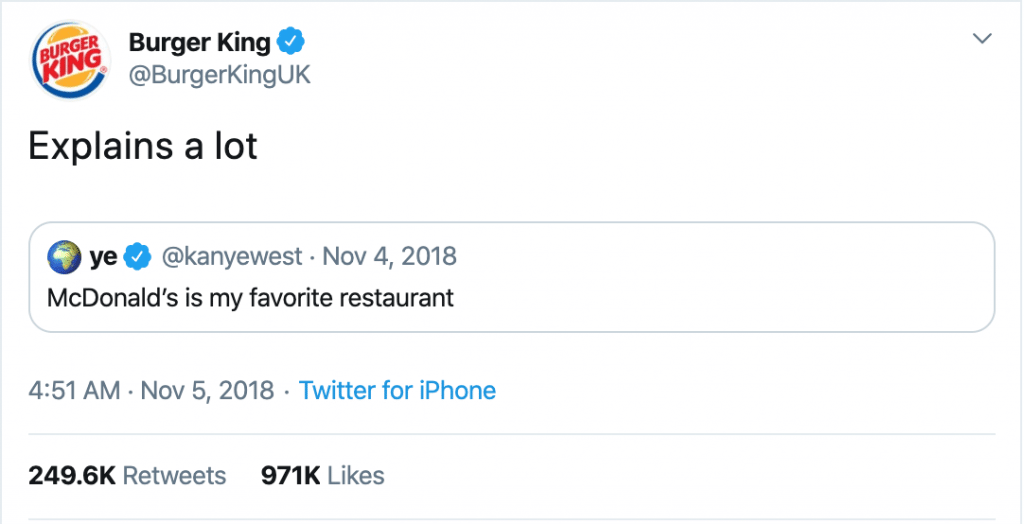
Burger King disses Kanye West and McDonalds in one Tweet.
There are unique personality traits for every brand—and the first step of creating your brand voice guidelines is to find them.
Think about who your brand is (and if you’re looking for a change, who you want your brand to be) and what personality traits go along with that image. Start a spreadsheet that looks like the model below—narrow down your list to about three to five and add them to the left-hand panel of your spreadsheet.
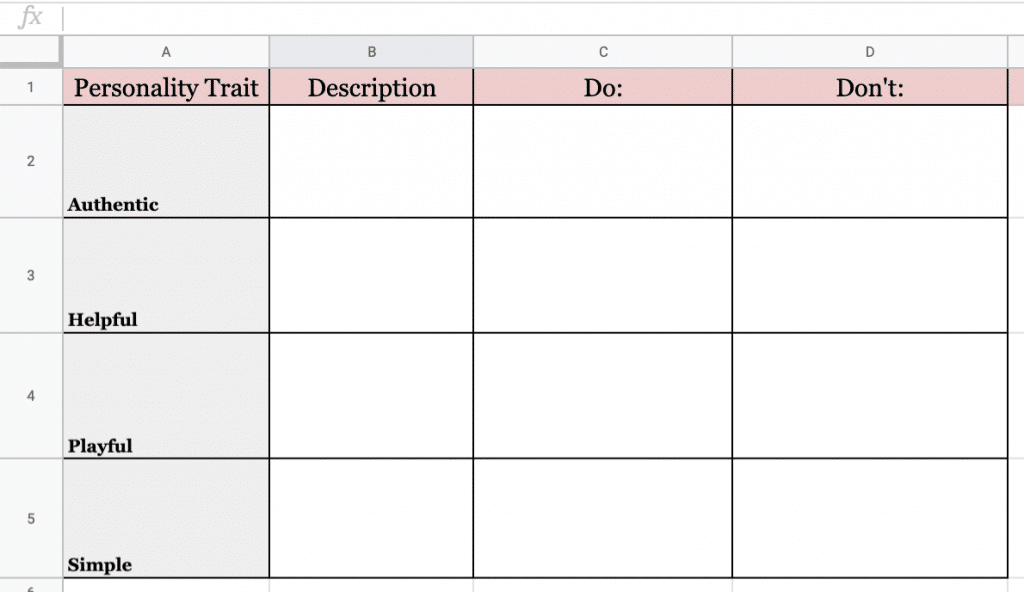
Shake the mindset that your brand personality “needs” to be professional, successful, or authoritative. While there’s certainly a space where all of these traits fit your audience, if your audience wouldn’t characterize themselves as these things, then you could struggle to make a connection.
Instead, think about what kind of traits your audience might have or what they’re looking for in a brand like yours.
3. Describe what those personality traits mean to your brand.
Personality traits may seem universal, but brands can manifest them in different ways. Authenticity in one company might look completely different than authenticity in another.
In this step, you need to define what those personality traits mean to you. Add these definitions under your Description column in the spreadsheet:
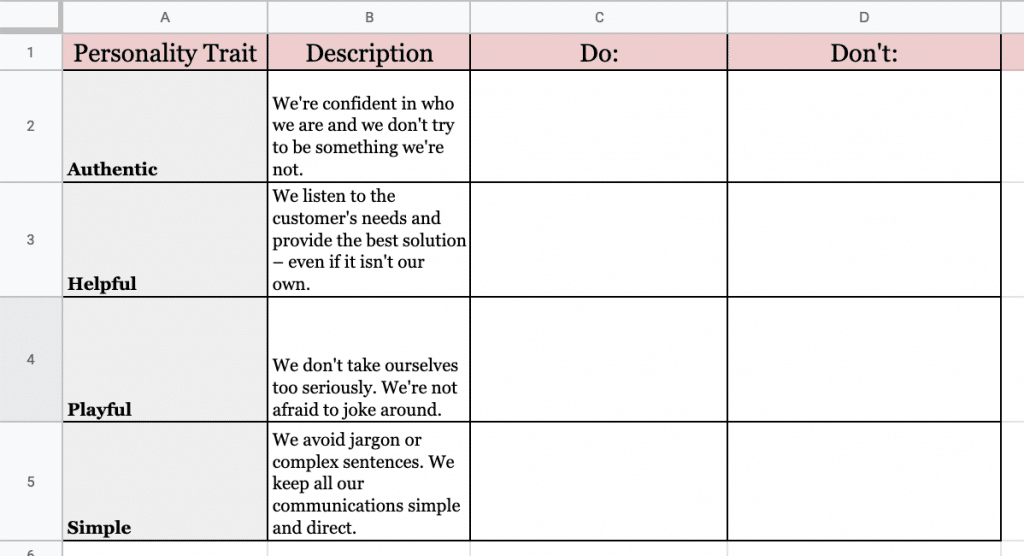
Try and keep your descriptions to just one or two sentences. While they might feel a bit loose right now, we’ll get into some more specific details next.
4. Establish your brand voice dos and don’ts.
Your brand voice dos and don’ts are exactly what they sound like––what you and your team should and shouldn’t do when bringing your brand voice to life.
Think of these like instructions for a new employee who’s not super familiar with your brand yet. They should be direct and to the point, but still comprehensive enough that someone who is just starting out can get a feel for what your brand voice sounds like.
Let’s start with the dos.
Think of some specific actions someone on your team could take that would bring out the brand personality traits you’ve established. How can a team member be authentic or helpful?
Add three to four bullet points in the Do column of your spreadsheet.
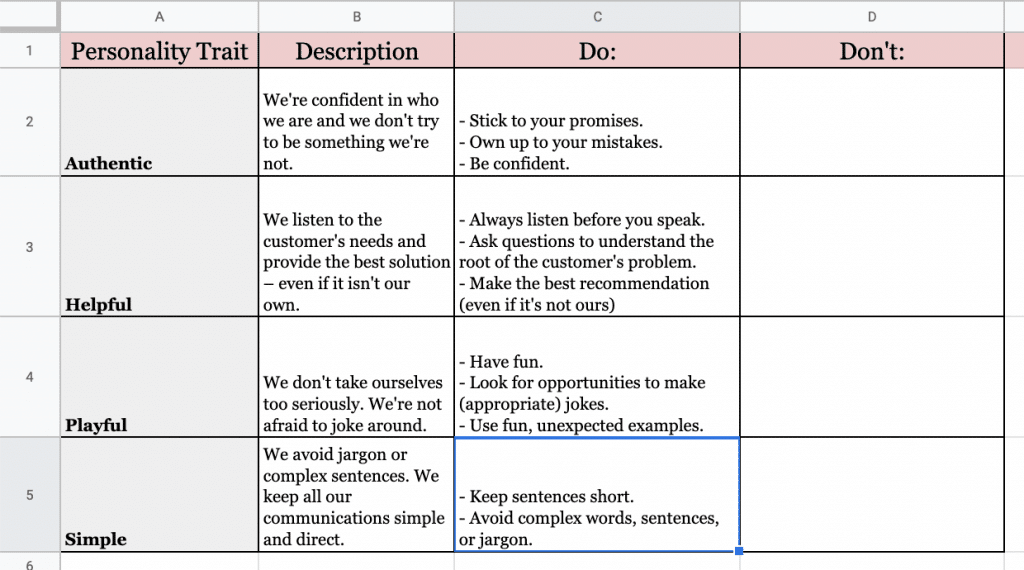
Some of these points may feel a little redundant from your descriptions, and that’s okay. It just means you’re being consistent. (Which is what we want!)
Once you’re satisfied with your dos, we’re ready to move to the don’ts.
Just like you imagined what actions your team could take to show the brand personality traits you’ve established, you now want to lay out what actions would contradict the brand voice.
Add those points to your ‘Don’t’ column:

The same rules apply to your Don’t column––it all needs to be consistent. If you feel like you’re repeating yourself, you probably are––and that’s a good thing.
4 examples of powerful brand voices
Because every brand personality is different, so is every brand voice. Although you need to create messaging that’s uniquely yours, you can draw some inspiration from these companies that nail their brand voices.
1. Wendy’s
Lately, it feels like you can’t get through a list of social media brand personalities without talking about Wendy’s––and for good reason. Wendy’s has one of the strongest brand voices out there.
If you’ve ever engaged with (or even just seen) the brand’s activity on Twitter, you know their brand voice can only be described as “sassy.”

They call out their competitors––and even their customers––with brutal takedowns, and they don’t hold back. Hey, their audience loves it.
What you can learn from Wendy’s:
- What is unique about Wendy’s brand voice is that not everyone can pull off the bullying-but-we-kind-of-love-it image they’ve created. If brands feel like they’re trying too hard to fit a persona they think their audience wants, it falls flat.
- Wendy’s went all in and created a unique, recognizable personality––and it works.
- Like Wendy’s, you need to be true to yourself. Go with the brand voice that feels most natural. If you try and replicate someone else’s brand, your audience might not respond as positively as you hoped.
2. Slack
The B2B space can be a little bit more challenging for building a unique brand voice. When everyone is trying to be professional and helpful, things can get a bit boring.
But Slack is one of the great brand voices in the space.
They don’t fall into the expected “business” brand voice. Instead, they’re quirky and accommodating––and even poke fun at themselves every so often.

Not every B2B brand can pull off rainbows and ice cream cones in their marketing.
What you can learn from Slack:
- For B2B brands in particular, Slack teaches you to be unique. Don’t allow yourself to be boxed in by what’s expected from you.
- By taking a different path––one that helps you stand out from the crowd––you can create a more memorable brand.
3. Dove
Dove has made it their mission to sell more than just bars of soap. They empower their customers to feel good in their own skin––and teach them how to take care of the skin they’re in.
Their brand voice is gentle yet confident, appearing from their commercials to their product descriptions.
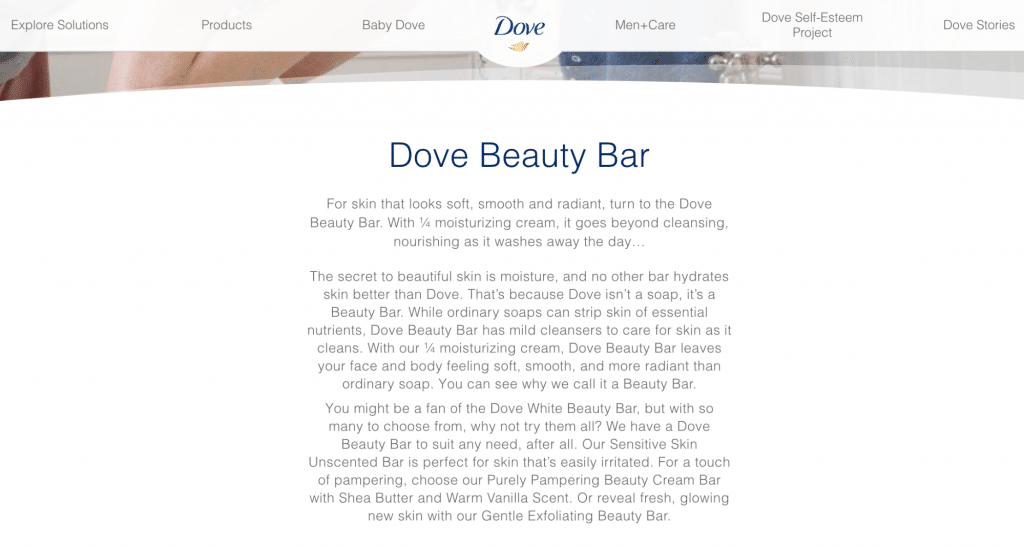
Dove uses every opportunity to educate their audience on taking proper care of their bodies. Rather than just pushing a soap, they speak to their audience––not at them.
What you can learn from Dove:
- Dove isn’t trying to grab attention by creating flashy messaging or making jokes. They’re staying true to their mission and owning that voice.
- Like Dove, stay true to yourself. Don’t get caught up copying what works for other brands.
4. Mailchimp
Mailchimp is another B2B brand that is doing an amazing job in creating their voice.
Their product differentiator is simplicity. Through an easy-to-use platform, Mailchimp makes email marketing accessible to everyone who wants to start a newsletter or connect with their audience through email.
And they apply that same simplicity to their website copy:

Their messaging is short, to the point, and direct. Just like their product is easy to use, their website is easy to read.
What you can learn from Mailchimp:
- We mentioned this a lot earlier, but your brand voice needs to be a reflection of your company––and Mailchimp does a great job at doing just that.
- When creating your brand personality and the traits that go along with it, make sure that voice is clear in everything you do, from your social media to your website to your customer communications.
Templates: the key to using your brand voice in customer and prospect communications
So now that you have your brand voice guidelines and you’ve seen how other brands are bringing their own voices to life, you’re ready to start using it.
But how?
Like we mentioned earlier, the key to building a strong brand voice is consistency. For your voice to be easily recognized and attributed to your brand, it needs to be present in everything you do.
Here’s how you can use your brand voice in customer and prospect communications.
1. Get everyone on board.
You can only create a consistent brand voice when everyone on your team is using the same language and messaging. To get everyone on the same page, share your brand voice template you created earlier. If necessary, hold a training for your team to make sure everyone understands the brand voice.
And when we say everyone, we mean everyone. From content creators to customer service, you need everyone, especially if they’re in a customer-facing role, to understand who your brand is and how they can contribute to bringing that brand to life.
2. Use your voice everywhere.
Your brand voice needs to appear in everything you do—on your website, in your blogs, on your social media accounts, and more.
If you’re able to successfully get everyone on the same page, this should come naturally. However, be sure each team is consistent. The language and messaging should be seamlessly as the customer moves through the sales funnel.
3. Put all your communication in one place.
Inconsistencies with brand voice can happen when your communication with customers and prospects are unorganized. If a salesperson is never communicating with a customer service rep, your customer or prospect could end up having entirely different and confusing experiences with your brand.
To solve this problem, use a centralized communication tool to bring together all your conversations (both internally and externally). Not only will this help your team connect better with customers, but it’ll also make collaboration between teams and departments easier.

For example, RingCentral unifies your digital conversations into one platform––allowing your team to respond to customers faster and giving you a more complete profile of your customers.
4. Shift your voice as necessary.
As with all your branding elements, your voice can become outdated. Trends change and new platforms appear, so you need to be prepared to change your brand voice or personality traits when it seems like you’re no longer making the impact you want.
This is another reason why having a good communication tool for your team is important. The sooner you can catch your audience losing interest in your voice, the faster you can work together to make changes. RingCentral also has a team messaging tool that lets you create groups, share files and docs, and even have a video call in real time.

If someone notices customers growing frustrated or leaving you for a competitor, it’s easy to message the team and look at revisiting your brand guidelines.
Use brand voice templates to make your brand voice feel like you
Establishing a brand voice can feel overwhelming––but it shouldn’t. At the end of the day, if you have a strong brand image and company values, your brand’s voice should be what comes naturally to you and your team.
Sometimes, the best thing is to just try things out and see what sticks. Write that funny Tweet, create that in-depth how-to article, or cut out jargon entirely––and see what happens.
Keep building on what works and what your audience is engaging with and change the rest. As you start to make some progress, fine-tuning your brand voice will get easier.
Originally published Mar 02, 2020, updated Sep 23, 2024



